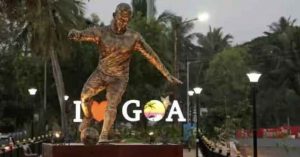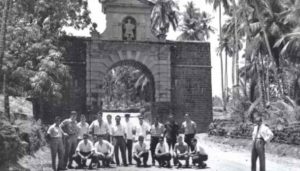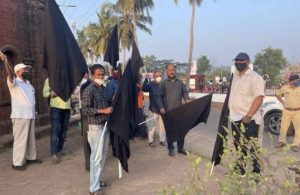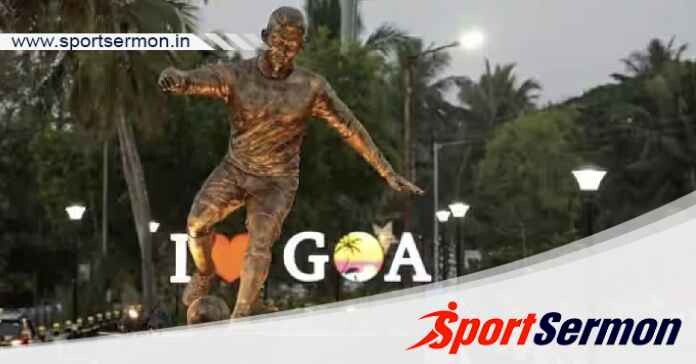In December 2021, a bronze statue of Portuguese Football legend Cristiano Ronaldo (b. 1985) was installed in the coastal town of Calangute, Goa (India) with the aim of motivating young people who are interested in the sport. But instead of having the intended impact, the statue was met with opposition right away from the community, who organised a protest wearing black flags.
When evaluating the immediate dispute surrounding the statue of Cristiano Ronaldo in Goa, two points emerged as the most compelling ones, as reported by news outlets (AFP, 2021; IANS, 2022; Sherwood, 2021). In summary, (1) the public display of a Portuguese football player rather than an Indian football player was a squandered chance to provide young Goans with Indian role models.
Football legend Cristiano Ronaldo statue in Goa:

In the latter case, Michael Lobo, a local minister for the Bharatiya party, which rules India, and an advocate of the statue’s installation, overlooked the fact that the new statue drew a controversial connection to Goa’s previous colonial history with Portugal. The news reports were mostly descriptive and offered scant to no analysis.
Even though they shed light on a colonial past that the statue sparked, they didn’t do much to further this past. Furthermore, no scholarly research on the controversy surrounding this statue has been done before this essay. In order to provide context for the statue and its controversy and to better understand the negative reactions that it has elicited, I will go into further detail about the colonial history that the statue has sparked, which goes beyond the current literature on the statue of Ronaldo in Goa.
In order to clarify the debate surrounding the statue, we will briefly discuss its history of Portuguese colonisation as well as the controversy surrounding it in this article. Claiming that, despite its good intentions, the statue honouring the Portuguese football player is a modern instance of cultural neocolonialism and that it has no place in Goa or any other part of India.
In Calangute, Goa, a statue of the Portuguese football legend Cristiano Ronaldo has been erected in an effort to uplift the sport and inspire the next generation of players. The statue, which weighs about 410 kg, was installed with the intention of inspiring the next generation to pursue their aspirations in sports.
Official statements on the statue:

“This is the first time Cristiano Ronaldo’s statue has appeared in India. All this is intended to do is motivate our young. Young boys and girls will look forward to this if they want to take football to the next level. They will take selfies, admire the statue, and be motivated to play. It is the responsibility of the panchayat, municipality, and government to provide good futsal, football, and infrastructure. For our boys and girls to go there and play, we need a decent infrastructure,” Goa minister Michael Lobo told ANI.
“Statues serve only as inspiration. Government-provided quality infrastructure is what we want. We require trainers who can instruct both our boys and girls. The government ought to appoint former athletes who represented Goa and brought honour to India as coaches. Only in this manner can we advance in the sports industry. We are far behind many other countries in terms of football, especially given our size.” he continued.
The minister went on to say that some individuals are against the statue’s installation because they don’t want to see the nation advance in sports. The minister remarked, “Someone has opposed the statue’s installation, and I believe that person to be a die-hard football fan. They do not regard football as a holy game. Everyone is treated equally in the game of football, regardless of caste, colour, religion, or anything else. These people are still raising black flags in opposition to it. I want to bow down to them and I can’t say anything about them.”
The statue, which has been planned for the past three years at a cost of about 12 lakhs, was postponed due to the COVID-19 pandemic.
Colonial Goa, football and iconoclasm:

Photo Source: Buala Org.
The Portuguese made their first landfall in India in 1497–1498 as a result of Vasco da Gama’s (1469–1524) expedition, which was celebrated in Luís Vaz de Camões’ (1524/5?–1580) epic poem Os Luísadas (1572). However, the Portuguese influence in India became more noticeable in 1510 after Afonso de Albuquerque (c. 1453–1515) led the Portuguese to conquer Goa (Saraiva, 1997: 49).
For a total of 450 years, Goa, Daman, and Diu were all a part of Portugal’s empire and collectively formed the Portuguese State of India, also known as Portuguese India. Moving forward to the 20th century, Portuguese territories in India turned into actual thorns in an otherwise independent republic in the 1950s after the country gained independence from British rule in 1947.
As a result, in December 1961, the Indian Army successfully annexed Portugal’s territories, motivated by the desire to end the last vestiges of European occupation in India. However, earlier in the summer of 1960, Portugal sent the football team from Lisbon, Benfica, to Goa for three friendly matches in what appeared to be an attempt by international condemnation of colonialism to persuade Goans of their imperial ties and obligations through the game of football (Todd Cleveland cited in Mergulhao, 2020).
Football has colonial overtones in India, much like cricket does. British soldiers introduced football to the country during their occupation of India in the late 1800s, though this had little effect on Portuguese India’s independence (Gupta and Sharma, 2019: 2). brought to Goa shortly after in 1883 by British priest William Robert Lyons (Mergulhao, 2021).
Consequently, football’s troubled colonial past and its purported past function of uniting Indians with Europeans and their culture are inextricably linked. Cultural imperialism, as exemplified by Benfica’s tour of Goa, is related to commemorative initiatives such as Portuguese imperial statues that also fulfilled this function. These cultural relics, which have always been contentious, still serve as a reminder of Portugal’s historical influence in Goa, Daman, and Diu.
Earliest Goa statue controversy:

The statue of Vasco da Gama at the centre of Viceroy’s Arch, the city’s entrance from the Mandovi River, was broken into pieces and scattered on January 4, 1601, sparking one of the first debates about statues in Goa (Flores and Marcocci, 2018: 463).
This act of political iconoclasm, although it was replaced (as shown in Fig. 3), was directed against a public symbol that stood for Portuguese hegemony. These depictions were frequently positioned throughout Portugal’s colonies to reorganise public areas and serve as memory sites for the Portuguese as a means of promoting their culture and authority.
A previous type of cultural imperialism existed in the 19th and 20th centuries, which is best described as cultural (soft) colonialism that went hand in hand with military (hard) colonialism.
Because of the legacy of colonialism and their symbolic significance, these kinds of representations of Portuguese men in stone and later bronze are highly charged with emotion in India. More recent statues honouring Portuguese people living in India, irrespective of their themes, are similarly contentious and subject to debate. Therefore, statues made in foreign personages’ former colonies today represent cultural neocolonialism rather than cultural imperialism from the past.
Cristiano Ronaldo as cultural neocolonialism:

Photo Source: Buala Org.
Ronaldo’s value as a cultural and even political lubricant is demonstrated by the 2017 Portuguese state visit to India, during which Portuguese Prime Minister António Costa gave Indian Prime Minister Narendra Modi a football jersey signed by the player (Biswas, 2017). Ronaldo, at most, has come to represent Portugal as a whole, a symbol of the country through which Portugal can (re)assert itself by sending a player to represent it abroad.
The most perplexing thing about the Ronaldo statue in Goa is that, aside from the aforementioned colonial past connected to his ancestors, the football player has no other connection to Goa or larger India.
There are arguments to be made in favour of the statue if Ronaldo is seen as a significant representative of the game of football, but these discussions draw attention away from an unavoidable past and a controversy connected to recent discussions about statues around the globe.
Unintentionally, there is a connection between the new Ronaldo statue in Goa and other contentious statue debates that erupted globally in the summer of 2020 around the issue of racist statues, many of which are still outside of Europe even though they were mostly removed during the 1945–1975 decolonization period.
Goa’s symbolic past:

Despite commemorating a peaceful athlete rather than violent imperialists and slave traders, the statue in Goa is symbolic of the state’s colonial past, as the Goan City Council imposed a form of cultural neocolonialism during the statue’s creation.
These arguments can be used to conceptualise this. The statue’s current location and the surrounding area will always have symbolic Portuguese meaning. Whereas an “I love Goa” sign next to the statue links Goa to Cristiano Ronaldo, who is synonymous with Portugal and its past.
By placing these symbolic objects in this way, a series of inadvertent choices create a reading of Portuguese culture that is superimposed over Indian culture as superior. In terms of football players or national teams, anyway.
These problems lead to a problematic memory matrix where the ghosts of Portuguese imperialism resurface and where Portugal’s former influence is reasserted, transmitting not an intended memory of Ronaldo the football player. Regarding these claims, and just to provide a counterargument, it’s possible that a large number of Goans prefer football to their native cricket.
Furthermore, admiration for Ronaldo is unquestionable and he can serve as a positive role model for young Goans who have an interest in football. Furthermore, Goans should preserve rather than eradicate their pride in their Portuguese ancestry and culture. These arguments, however, are insufficient to disprove the statue’s capacity to evoke a contentious past or defend its placement in Goa.
Final Word:
This article could have covered a lot more ground regarding the controversy surrounding the Cristiano Ronaldo statue in Goa. A discussion of colonial nostalgia and whether or not it exists for Goans would have been an interesting addition. even to find out what Cristiano Ronaldo believes the Goa statue means to him.
However, it is evident that Ronaldo is innocent in the matter under discussion, in which the football player who represents Portugal and consequently its imperial past is at fault. Overall, the Ronaldo statue has demonstrated a lack of respect and consideration for Goa’s colonial past on the part of city officials, despite arguments against the statue indicating that locals had more important things to consider.
Though there is opposition to a statue of the football player, it is widely acknowledged that Ronaldo is an incredible player with exceptional skill and an unusual career who deserves to be monumentalized. But it appears that every statue made in his honour up to this point has been examined closely.
The 2017 bust was removed after bearing little resemblance to the football player and displayed in his native Madeira, Portugal (Acres, 2018). To the Goan statue that has served as the subject of this essay. Thus, perhaps other commemorative techniques—apart from material structures—should be employed to honour Ronaldo.
Concluding approach:
One approach might be for the football player to get involved in charitable work in Goa, like raising money for nearby football schools. But because of Portugal’s colonial past, these initiatives could also be seen as problematic. The football player’s financial support or charitable donations made in his name could be seen as neocolonialist gestures that, albeit in very small ways, recall Portugal’s previous colonial position in Goa.
Consequently, Goa’s contemporary Portuguese influence must be carefully considered in order to prevent it from growing beyond what is already there and to maintain the protection of Portuguese cultural heritage that existed there before 1961 rather than introducing new influences in the form of statues that, even if they are self-inflicted and done so without Portugal’s direct involvement, symbolise cultural neocolonialism. Overall, because of its provocative nature, the statue ought to be taken down and removed.
The presence of this illogical memorial statue in Goa also serves as a troubling and eerie reminder of Portuguese colonial rule in India. This is not because Ronaldo is to blame; rather, people should protest his portrayal in Goa in a manner akin to that of the black flag protestors, for the reasons I have touched on in this article.
So, this was all about the Football legend Cristiano Ronaldo statue in Goa and its controversy. Also read, Top 5 horrific career-ending injuries in football

